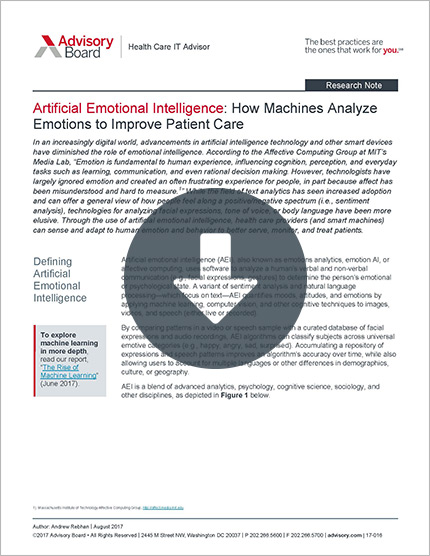Auto logout in seconds.
Continue LogoutRead Advisory Board's take on this story.
Using actors or computerized mannequins to simulate medical situations to teach students can be a costly venture—and some medical schools are instead turning to mixed- and virtual-reality programs, which can be a cheaper alternative, Leigh Kamping-Carder reports for the Wall Street Journal.
A shift to mixed and virtual reality
According to the Journal, virtual-reality programs "immers[e] users in a fully virtual environment," whereas mixed-reality programs add virtual elements to a user's real surroundings, such as making "a three-dimensional, life-size patient avatar appea[r] in a real-life classroom."
Learn about the current uses and future applications of virtual reality in health care
Some schools—including Texas Tech University Health Sciences Center, Western University of Health Sciences (WUHS) in California, and the University of Nebraska Medical Center—have begun using so-called "simulation centers" to help teach students how to care for patients. The facilities feature mock hospital settings, 360-degree video, interactive digital walls, and a mix of virtual- and mixed-reality headsets and holographic-projection screens. The facilities allow teachers to simulate certain patient situations, such as patient falls, to which they otherwise might not be able to expose their students.
On a smaller scale, other schools, like San Diego State University (SDSU), have started using a program called HoloPatient, one of a suite of applications developed by the education company Pearson for Microsoft's HoloLens headset. When a user puts on the headset and presses a button, a three-dimensional, life-size avatar of a patient appears in the classroom. Over the past two years, Pearson has developed three scenarios for HoloPatient—an injured cyclist who goes into anaphylactic shock, an older adult taking a balance test, and a patient with chronic obstructive pulmonary disease.
The advantages of using mixed and virtual reality
Philip Greiner, director of SDSU's school of nursing, said mixed- and virtual-reality programs provide schools with a cheaper alternative to teach students when compared with hiring actors, who have to be brought in multiple times for each class, or computerized mannequins, which can cost up to $60,000 and require expensive maintenance. According to Kamping-Carder, HoloPatient packages cost $50,000 and include four HoloLens headsets and full access to HoloPatient's software suite.
Greiner sees using mixed- and virtual-reality programs as a way to help students experience real-world settings that otherwise would be inaccessible. "Do I want my students to experience a patient fall? Absolutely not," he said. But to prepare them for that exact scenario, "I want to be able to reproduce that for every single one of my students."
According to Robert Hasel, a former associate dean at WUHS, the development of mixed- and virtual-reality programs "is creating a revolution in the way we teach medical science."
However, these programs aren't perfect by any stretch, Kamping-Carder writes, noting that simulated patients through HoloPatient can't respond to questions and can't be touched by students. But according to Mark Christian, Pearson's global director of immersive learning, these programs are "helping in terms of cost, scalability, repeatability, and access to the experience" (Kamping-Carder, Wall Street Journal, 7/5).
Advisory Board's take


Naomi Levinthal, Practice Manager, Health Care IT Advisor, and Andrew Rebhan, Consultant, Health Care IT Advisor
Virtual reality (VR) and augmented reality (AR) technologies hold great potential to disrupt health care. Although often labeled emerging technologies, VR and AR have been tested for decades across a number of applications, including rehabilitation and pain management; psychiatric and behavioral health treatment; and general health and wellness (e.g., stress management, recreation).
However, the most common use case for VR/AR is what this article mentions: medical education and training. Medical students, researchers, and clinicians can use holographic and immersive devices to perform a variety of functions, including:
- clinical skills training;
- surgery planning;
- tele-mentoring;
- and patient education.
With these tools, health sciences programs can simulate real-world patient care scenarios in a way that may be too costly, impractical, or risky to do in reality. In addition, by working in an interactive digital environment, users can have unlimited interaction with 3D models, which can also spark more creative learning opportunities in a low-risk setting (and without the need for an actor, mannequin, or cadaver).
“Including digital experiences in medical training can help scale medical education and reduce geographic barriers”
Including digital experiences in medical training can also help scale medical education and reduce geographic barriers. For instance, many head-mounted displays (HMDs) now allow users to record their experiences to share virtually (and in some cases, with real-time streaming) with students, patients, or other clinicians. This can reduce the need for brick-and-mortar medical schools.
However, despite the potential of VR and AR beyond medical training, it's far too early for such tools to become standard for patient care. Rather, future adoption will depend upon more controlled, well-designed studies to prove that the technology is both clinically-sound and cost-effective at scale.
The market seems to be pushing in this direction. Ongoing technological developments in HMDs, smart glasses, smartphones, and the billions invested in the market by major vendors such as Google, Microsoft, and Facebook will likely be a catalyst for greater future adoption.
For providers looking to test AR/VR initiatives, we suggest four imperatives:
Initiatives should not be isolated or sporadic, but rather well-planned and implemented widely.
When a use case is ready for broad adoption, it should receive input from a multidisciplinary group of stakeholders.
Health care organizations should assign a project team to drive any VR/AR initiative, with at least one executive champion who will be held accountable to identify the overall objectives of the program, and guide the organization throughout planning, procurement, and implementation.
Organizations should consider partnering directors with vendors who want to test their products. This allows organizations to also test a use case before considering a larger deployment.
To learn more about virtual and augmented reality, including the pros, cons, use cases and adoption trends, view our research report on virtual reality and research note on augmented reality.
Don't miss out on the latest Advisory Board insights
Create your free account to access 1 resource, including the latest research and webinars.
Want access without creating an account?
You have 1 free members-only resource remaining this month.
1 free members-only resources remaining
1 free members-only resources remaining
You've reached your limit of free insights
Become a member to access all of Advisory Board's resources, events, and experts
Never miss out on the latest innovative health care content tailored to you.
Benefits include:
You've reached your limit of free insights
Become a member to access all of Advisory Board's resources, events, and experts
Never miss out on the latest innovative health care content tailored to you.
Benefits include:
This content is available through your Curated Research partnership with Advisory Board. Click on ‘view this resource’ to read the full piece
Email ask@advisory.com to learn more
Click on ‘Become a Member’ to learn about the benefits of a Full-Access partnership with Advisory Board
Never miss out on the latest innovative health care content tailored to you.
Benefits Include:
This is for members only. Learn more.
Click on ‘Become a Member’ to learn about the benefits of a Full-Access partnership with Advisory Board
Never miss out on the latest innovative health care content tailored to you.

